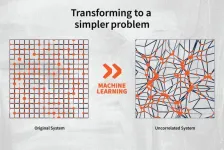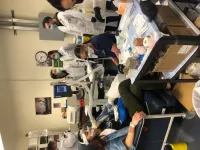(Press-News.org) Irvine, Calif., May 14, 2024 — A research team led by the University of California, Irvine has revealed the link between the frequency of sleep apnea events during the rapid-eye-movement stage and the severity of verbal memory impairment in older adults at risk for Alzheimer’s disease. Verbal memory refers to the cognitive ability to retain and recall information presented through spoken words or written text and is particularly vulnerable to Alzheimer’s.
The study, recently published online in the journal Alzheimer’s Research & Therapy, discovered a specific correlation between the severity of sleep apnea – when breathing pauses while an individual is sleeping – and diminished cognition. Higher ratios during REM compared to non-REM stages were associated with worse memory performance.
“Our findings identified the specific features of sleep apnea that are associated with memory, which is important because clinically, events occurring during REM sleep are often overlooked or minimized,” said co-corresponding author Bryce Mander, UC Irvine associate professor of psychiatry & human behavior. “Most hours of sleep are non-REM, so the overall averages of apnea severity can look much lower than what is typically observed during REM sleep. This means that someone at risk can be misdiagnosed and undertreated because current evaluation standards are not focused on sleep-stage-specific apnea severity.”
“Furthermore,” said co-corresponding author Ruth Benca, professor and chair of psychiatry and behavioral medicine at Wake Forest University School of Medicine, “we found that women are more likely to have a greater proportion of their apneic events in REM sleep in comparison to men, which could potentially be contributing to their greater risk for Alzheimer’s disease.”
The study involved 81 middle-aged and older adults from the Wisconsin Alzheimer’s Disease Research Center with heightened risk factors, of whom 62 percent were female. Participants underwent polysomnography – a comprehensive test that records brain waves, eye movements, muscle activity, blood oxygen levels, heart rate and breathing during sleep – and verbal memory assessments. Results showed apnea events during REM to be a critical factor contributing to verbal memory decline, especially among individuals with a genetic predisposition to Alzheimer’s and those with a parental history of the disease.
“Our findings highlight the intricate relationship among sleep apnea, memory function and Alzheimer’s risk,” Mander said. “Identifying and addressing REM-specific events are crucial for developing proactive, personalized approaches to assessment and treatment that are tailored to individual sleep patterns.”
The team also included lead author Kitty K. Lui, a graduate student in the San Diego State University/University of California, San Diego joint doctoral program in clinical psychology, and faculty and graduate students from UC Irvine, UC San Diego, the Wisconsin Alzheimer’s Disease Research Center and the University of Kentucky.
This work was supported by the National Institute on Aging under grants R56 AG052698, R01 AG027161, R01 AG021155, ADRC P50 AG033514, R01 AG037639 and K01 AG068353; by the National Institutes of Health’s Ruth L. Kirschstein National Research Service Award F31 AG048732; and by the National Center for Advancing Translational Sciences’ Clinical and Translational Science Awards Program under grant UL1TR000427.
About the University of California, Irvine: Founded in 1965, UC Irvine is a member of the prestigious Association of American Universities and is ranked among the nation’s top 10 public universities by U.S. News & World Report. The campus has produced five Nobel laureates and is known for its academic achievement, premier research, innovation and anteater mascot. Led by Chancellor Howard Gillman, UC Irvine has more than 37,000 students and offers 224 degree programs. It’s located in one of the world’s safest and most economically vibrant communities and is Orange County’s second-largest employer, contributing $7 billion annually to the local economy and $8 billion statewide. For more on UC Irvine, visit www.uci.edu.
Media access: Radio programs/stations may, for a fee, use an on-campus ISDN line to interview UC Irvine faculty and experts, subject to availability and university approval. For more UC Irvine news, visit news.uci.edu. Additional resources for journalists may be found at https://news.uci.edu/media-resources.
END
UC Irvine-led study links sleep apnea severity during REM stage to verbal memory decline
Novel findings among elders at risk for Alzheimer’s open door to personalized interventions
2024-05-14
ELSE PRESS RELEASES FROM THIS DATE:
What’s actually in your supplements? Chapman University researchers detect hidden ingredients and questionable claims in supplements
2024-05-14
A recent study published in Analytical Science Journal conducted by Schmid College of Science and Technology Professor Rosalee Hellberg and students Calin Harris, Diane Kim, Miranda Miranda and Chevon Jordan, reveal that some supplement companies may mislead customers with unproven health claims and undeclared ingredients.
The researchers focused on supplements that have been associated with the purported treatment or prevention of COVID-19 and other respiratory illnesses. During the pandemic, the use of dietary supplements skyrocketed throughout the world. “There was a big spike in purchase and use of these types ...
STRIVE project to study ozone, atmospheric layers among finalists for next-generation NASA satellite
2024-05-14
A project led by the University of Washington to better understand our atmosphere’s complexity is a finalist for NASA’s next generation of Earth-observing satellites. The space agency this week announced the projects that will each receive $5 million to advance to the next stage and conduct a one-year concept study.
STRIVE seeks to better understand the troposphere that we inhabit and the stratosphere above it, where the ozone layer is, as well as the interface where these two layers meet. That interface, about 6 miles (10 kilometers) above the surface, is where important ...
Simulating diffusion using 'kinosons' and machine learning
2024-05-14
Researchers from the University of Illinois Urbana-Champaign have recast diffusion in multicomponent alloys as a sum of individual contributions, called “kinosons.” Using machine learning to compute the statistical distribution of the individual contributions, they were able to model the alloy and calculate its diffusivity orders of magnitude more efficiently than computing whole trajectories. This work was recently published in the journal Physical Review Letters.
“We found a much more efficient way to calculate diffusion in solids, and at the same time, we learned more ...
Far from toxic, lactate rivals glucose as body's major fuel after a carbohydrate meal
2024-05-14
As a student competing in track and field at his Parlier high school, Robert Leija was obsessed with how to improve his performance and, in particular, prevent the buildup of lactic acid in his muscles during training. Like many athletes, he blamed it for the performance fatigue and muscle soreness he experienced after intense workouts.
But as a kinesiology student at Fresno State, he was handed an out-of-print textbook that told him he had it all wrong. Lactate wasn't a danger sign that athletes had depleted their body's supply of oxygen, but likely a normal product of the metabolic activity required to fuel the muscles during sustained exercise.
Now, as a graduate student ...
AI for more caring institutions
2024-05-14
More and more public services — such as affordable housing, public school matching and child welfare — are relying on algorithms to make decisions and allocate resources. So far, much of the work that has gone into designing these systems has focused on workers’ experiences using them or communities’ perceptions of them.
But what about the actual impact of these programs have on people, especially when the decisions the systems make lead to denial of services? Can you design algorithms to help people make sense of and ...
Astronomers spot a giant planet that is as light as cotton candy
2024-05-14
Astronomers at MIT, the University of Liège in Belgium, and elsewhere have discovered a huge, fluffy oddball of a planet orbiting a distant star in our Milky Way galaxy. The discovery, reported today in the journal Nature Astronomy, is a promising key to the mystery of how such giant, super-light planets form.
The new planet, named WASP-193b, appears to dwarf Jupiter in size, yet it is a fraction of its density. The scientists found that the gas giant is 50 percent bigger than Jupiter, and about a tenth as dense — an extremely low density, comparable to that of cotton candy.
WASP-193b is the second lightest planet discovered to date, ...
Sleep experts to convene in Houston for SLEEP 2024 annual meeting
2024-05-14
DARIEN, IL – Leading sleep and circadian scientists, sleep clinicians, and industry innovators will gather June 2-5 in Houston at SLEEP 2024, the 38th annual meeting of the Associated Professional Sleep Societies, LLC. Thousands of sleep professionals will connect, explore, and grow at the world’s premier clinical and scientific sleep meeting, held jointly by the American Academy of Sleep Medicine and the Sleep Research Society.
“Every year, SLEEP brings together the world’s ...
Rice’s Mamouras wins NSF CAREER Award
2024-05-14
HOUSTON – (May 14, 2024) – As the Internet of Things (IoT) grows larger and more complex, it becomes increasingly difficult to develop applications.
“A common approach to this problem is to move data from the sensing devices to a central location, such as the cloud, for processing,” said Konstantinos Mamouras, assistant professor of computer science at Rice University. “But this centralized approach underutilizes the small IoT devices at the edge of the network and can overwhelm it due to the large movement of data.”
With his five-year, $547,555 National Science Foundation CAREER Award, Mamouras aims to decentralize the IoT, relieve network congestion and ...
ISS National Lab announces up to $750,000 in funding for technology development in low Earth orbit
2024-05-14
KENNEDY SPACE CENTER (FL), May 14, 2024 – The International Space Station (ISS) National Laboratory is soliciting flight concepts for technology development that would utilize the space-based environment of the orbiting laboratory. This solicitation, “Technology Development and Applied Research Leveraging the ISS National Lab,” is open to a broad range of technology areas, including chemical and material synthesis in space, translational medicine, in-space edge computing, and ISAM (in-space servicing, assembly, and manufacturing). ...
Counterfeit coins can be detected more easily thanks to a novel approach developed at Concordia
2024-05-14
Metal coins may be just about the oldest medium of exchange still in use today, but ensuring their worth requires some of the most state-of-the-art technology available. Counterfeit coins remain a threat to global currencies, with malicious actors flooding markets with fakes. European police broke up a Spain-based criminal ring in late April, demonstrating the issue’s ongoing urgency.
However, no counterfeit is completely detection-proof, no matter how genuine it appears. There are always some tell-tale signals of forgery, even if they are not ...
LAST 30 PRESS RELEASES:
Pusan National University researchers discover faster, smarter heat treatment for lightweight magnesium metals
China’s 2024 Gastroenterology Report: marked progress in endoscopy quality and disease management
Pusan National University researchers uncover scalable method for ultrahigh-resolution quantum dot displays
Researchers use robotics to find potential new antibiotic among hundreds of metal complexes
Gut bacteria changes at the earliest stages of inflammatory bowel disease
Scientists develop new way to “listen in” on the brain’s hidden language
Brain research: “Pulse generators” grow and shrink as memories are formed
For teens, any cannabis use may have impact on emotional health, academic performance
School meals could unlock major gains for human and planetary health
Menopause hormone therapy does not appear to impact dementia risk
Signature patterns of brain activity may help predict recovery from traumatic brain injury
Dresden study uncovers new key mechanism in cancer cells
New species are now being discovered faster than ever before, study suggests
Cannabis-based products show limited short-term benefit for chronic pain, with increased risk of adverse effects
Cannabis products with more THC slightly reduce pain but cause more side effects
Clearing the brain of aging cells could aid epilepsy and reduce seizures
Brain injuries linked with potential risk of suicide, new study finds
New technique lights up where drugs go in the body, cell by cell
New study finds movement of fishing fleets can reveal shifts in marine ecosystems
Embargoed: New evidence points to potential treatment for vascular dementia
Study uncovers disrupted brain balance in alcohol dependence
Working in groups can help Republicans and Democrats agree on controversial content moderation online
Structural findings reveal how distinct GPCR ligands create different levels of activation
Anything-goes “anyons” may be at the root of surprising quantum experiments
UC review: Maximizing workplace opportunity for veterans
From generation to complex control: Metasurfaces make perfect vortex beams "within reach"
Thin-film lithium niobate-based detector: recent advances and perspectives
Exploring why some people may tend to persistently make bad choices
How cells balance their protein levels
Nirsevimab vs RSVpreF vaccine for RSV–related hospitalization in newborns
[Press-News.org] UC Irvine-led study links sleep apnea severity during REM stage to verbal memory declineNovel findings among elders at risk for Alzheimer’s open door to personalized interventions




